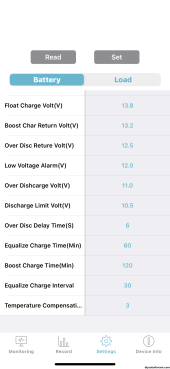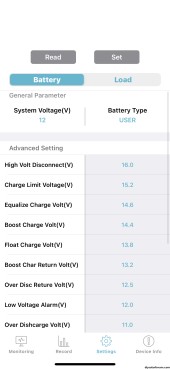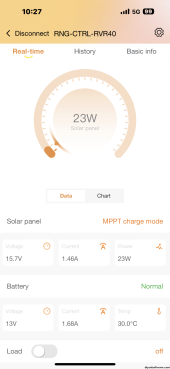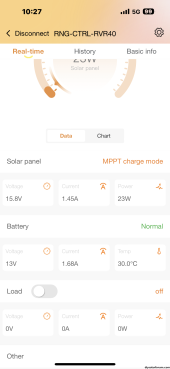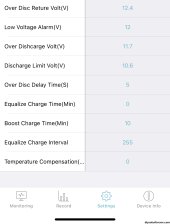Hi all,
I have the current setup.
Renogy Rover 40amp SCC
Flexible panels - https://www.amazon.com/Topsolar-Flexible-Solar-Monocrystalline-Bendable/dp/B09B1HJZBR?th=1
2 Lifepo Batteries - https://www.amazon.com/SCREMOWER-Li...llel/dp/B08G8HXNJK?ref_=v_sp_product_dpx&th=1
Panels run in parallel and tested good. Voltage and amps were what I expect when connected together and tested individually. They go from panels thru a cutoff switch then into the Rover. Batteries are connected to rover and batteries power a small 500w inverter and a fuse panel of lights and such.
Problem is, the amps I measure at the panels with a multimeter (roughly 5amps today) never show at the controller. I have the DC home app and the voltage seems correct (around 18v) but the amperage and charging voltage shows .5 amps. It's hot outside but battery says it's at 105f.
I set the charge controller to the generic Lithium setting but I wonder if I need to set up each individual parameter in the BT app? Do I need to get those values from the manufacturer?
Anyone know how I can contact Scremower? I tried going through amazon but their AI thinks I just want to return the product.
Any help would be appreciated.
Thanks!
I have the current setup.
Renogy Rover 40amp SCC
Flexible panels - https://www.amazon.com/Topsolar-Flexible-Solar-Monocrystalline-Bendable/dp/B09B1HJZBR?th=1
2 Lifepo Batteries - https://www.amazon.com/SCREMOWER-Li...llel/dp/B08G8HXNJK?ref_=v_sp_product_dpx&th=1
Panels run in parallel and tested good. Voltage and amps were what I expect when connected together and tested individually. They go from panels thru a cutoff switch then into the Rover. Batteries are connected to rover and batteries power a small 500w inverter and a fuse panel of lights and such.
Problem is, the amps I measure at the panels with a multimeter (roughly 5amps today) never show at the controller. I have the DC home app and the voltage seems correct (around 18v) but the amperage and charging voltage shows .5 amps. It's hot outside but battery says it's at 105f.
I set the charge controller to the generic Lithium setting but I wonder if I need to set up each individual parameter in the BT app? Do I need to get those values from the manufacturer?
Anyone know how I can contact Scremower? I tried going through amazon but their AI thinks I just want to return the product.
Any help would be appreciated.
Thanks!



